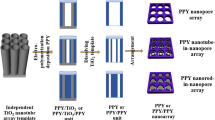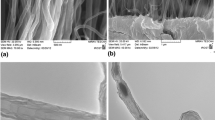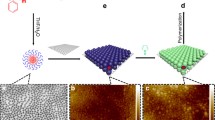Abstract
High-temperature (150–220 °C) growth leads to the formation of some peptide nanotube/microtube (NT/MT) arrays but the NTs/MTs exhibit closed ends, irreversible phase modification and eliminations of piezoelectric and hydrophilic properties. Here we demonstrate the fabrication of unidirectionally aligned and stable diphenylalanine NT/MT arrays with centimeter scale area at room temperature by utilizing an external electric field. The interactions between the applied electric field and dipolar electric field on the NTs and surface positive charges are responsible for the formation. The unidirectionally aligned MT array exhibits a supercapacitance of 1,000 μF·cm−2 at a scanning rate of 50 mV·s−1; this is much larger than the values reported previously in peptide NT/MT arrays.

Similar content being viewed by others
References
Yan, X. H.; Zhu, P. L.; Li, J. B. Self-assembly and application of diphenylalanine-based nanostructures. Chem. Soc. Rev. 2010, 39, 1877–1890.
Kol, N.; Adler-Abramovich, L.; Barlam, D.; Shneck, R. Z.; Gazit, E.; Rousso, I. Self-assembled peptide nanotubes are uniquely rigid bioinspired supramolecular structures. Nano Lett. 2005, 5, 1343–1346.
Carny, O.; Shalev, D. E.; Gazit, E. Fabrication of coaxial metal nanocables using a self-assembled peptide nanotube scaffold. Nano Lett. 2006, 6, 1594–1597.
Kholkin, A.; Amdusky, N.; Bdikin, I.; Gazit, E; Rosenman, G. Strong piezoelectricity in bioinspired peptide nanotubes. ACS Nano 2010, 4, 610–614.
Bdikin, I.; Bystrov, V.; Kopyl, S.; Lopes, R. P. G.; Delgadillo, I.; Gracio, J.; Mishina, E.; Sigov, A.; Kholkin, A. L. Evidence of ferroelectricity and phase transition in pressed diphenylalanine peptide nanotubes. Appl. Phys. Lett. 2012, 100, 043702.
Aida T.; Meijer, E.; Stupp, S. I. Functional supramolecular polymers. Science 2012, 335, 813–817.
Ryu, J.; Park, C. B. High stability of self-assembled peptide nanowires against thermal, chemical, and proteolytic attacks. Biotechnol. Bioeng. 2010, 105, 221–230.
Alder-Abramovich, L.; Reches, M.; Sedman, V. L.; Allen, S.; Tendler, S. J. B.; Gazit, E. Thermal and chemical stability of diphenylalanine peptide nanotubes: implications for nanotechnological application. Langmuir 2006, 22, 1313–1320.
Reches, M.; Gazit, E. Casting metal nanowires within discrete self-assembled peptide nanotubes. Science 2003, 300, 625–627.
Yan, X. H.; Li, J. B.; Möhwald, H. Self-assembly of hexagonal peptide microtubes and their optical waveguiding. Adv. Mater. 2011, 23, 2796–2801.
Beker, P.; Koren, N.; Amdursky, N.; Gazit, E.; Rosenman, G. Bioinspired peptide nanotubes as supercapacitor electrodes. J. Mater. Sci. 2010, 45, 6374–6378.
Adler-Abramovich, L.; Aronov, D.; Beker, P.; Yevnin, M.; Stempler, S.; Buzhansky, L. Rosenman, G.; Gazit, E. Self-assembled arrays of peptide nanotubes by vapour deposition. Nat. Nanotechnol. 2009, 4, 849–853.
Wang, Z. L.; Song, J. H. Piezoelectric nanogenerators based on zinc oxide nanowire arrays. Science 2006, 312, 242–246.
Kumar, B.; Lee, K. Y.; Park, H. K.; Chae, S. J.; Lee, Y. H.; Kim, S. W. Controlled growth of semiconducting nanowire, nanowall, and hybrid nanostructures on graphene for piezoelectric nanogenerators. ACS Nano 2011, 5, 4197–4204.
Yemini, M.; Reches, M.; Rishpon, T.; Gazit, E. Novel electrochemical biosensing platform using self-assembled peptide nanotubes. Nano Lett. 2005, 5, 183–186.
Reches, M.; Gazit, E. Controlling patterning of aligned self-assembled peptide nanotubes. Nat. Nanotechnol. 2006, 1, 195–200.
Ryu, J.; Park, C. B. High-temperature self-assembly of peptides into vertically well-aligned nanowires by aniline vapor. Adv. Mater. 2008, 20, 3754–3758.
Ryu, J.; Park, C. B. Solid-phase growth of nanostructures from amorphous peptide thin film: Effect of water activity and temperature. Chem. Mater. 2008, 20, 4284–4290.
Sedman, V. L.; Adler-Abramovich, L.; Allen, S.; Gazit, E.; Tendler, S. J. B. Direct observation of the release of phenylalanine from diphenylalanine nanotubes. J. Am. Chem. Soc. 2006, 128, 6903–6908.
Ryu, J.; Park, C. B. Synthesis of diphenylalanine/polyaniline core/shell conducting nanowires by peptide self-assembly. Angew. Chem. Int. Ed. 2009, 48, 4820–4823.
Wang, M. J.; Du, L. J.; Xiong, S. J.; Wu, X. L.; Chu, P. K. Charged diphenylalanine nanotubes and controlled hierarchical self-assembly. ACS Nano 2011, 5, 4848–4854.
Singh, G.; Bittner, A. M.; Loscher, S.; Malinnovski, N.; Kern, K. Electrospinning of diphenylalanine nanotubes. Adv. Mater. 2008, 20, 2332–2336.
Han, T. H.; Kim, J.; Park, J. S.; Park, C. B.; Ihee, H.; Kim, S. O. Liquid crystalline peptide nanowires. Adv. Mater. 2007, 19, 3924–3927.
Görbizt, C. H. Microporous organic materials from hydrophobic dipeptides. Chem. Eur. J. 2007, 13, 1022–1031.
Görbizt, C. H. Nanotube formation by hydrophobic dipeptides. Chem. Eur. J. 2001, 7, 5153–5159.
Görbitz, C. H. The structure of nanotubes formed by diphenylalanine, the core recognition motif of Alzheimer’s β-amyloid polypeptide. Chem. Comm. 2006, 2332–2336.
Zhu, P.; Yan, X.; Su, Y.; Yang, Y.; Li, J. Solvent-induced structural transition of self-assembled dipeptide: From organogels to microcrystals. Chem. Eur. J. 2010, 16, 3176–3183.
Guo, C.; Luo, Y.; Zhou, R. H.; Wei, G. H. Probing the self-assembly mechanism of diphenylalanine-based peptide nanovesicles and nanotubes. ACS Nano 2012, 6, 3907–3918.
Amaral, H. R.; Jr, Kogikoski, S.; Silva, E. R.; Souza, J. A.; Alves, W. A. Micro- and nano-sized peptideic assemblies prepared via solid-vapor approach: Morphological and spectroscopic aspects. Mater. Chem. Phys. 2012, 137, 628–636.
Huang, R. L.; Qi, W.; Su, R. X.; Zhao, J.; He, Z. M. Solvent and surface controlled self-assembly of diphenylalanine peptide: From microtubes to nanofibers. Soft Matter 2011, 7, 6418–6421.
Jonkheijm, P.; van der Schoot, P.; Schenning, A. P. H. J.; Meijer, E. W. Probing the solvent-assisted nucleation pathway in chemical self-assembly. Science 2006, 313, 80–83.
Andrade-Filho, T.; Ferreira, F. F.; Alves, W. A.; Rocha, A. R. The effects of water molecules on the electronic and structural properties of peptide nanotubes. Phys. Chem. Chem. Phys. 2013, 15, 7555–7559.
Bdikin, I.; Bystrov, V.; Delgadillo, I.; Gracio, J.; Kopyl, S.; Wojtas, M.; Mishina, E.; Sigov, A.; Kholkin, A. L. Polarization switching and patterning in self-assembled peptide tubular structures. J. Appl. Phys. 2012, 111, 074104.
Sun, B. Q.; Sirringhaus, H. N. Surface tension and flow driven self-assembly of ordered ZnO nanorod films for high-performance field transistors. J. Am. Chem. Soc. 2006, 128, 16231–16237.
Handelman, A.; Beker, P.; Amdursky, N.; Rosenman, G. Physics and engineering of peptide supramolecular nanostructures. Phys. Chem. Chem. Phys. 2012, 14, 6391–6408.
Rosenman, G.; Beker, P.; Koren, I.; Yevnin, M.; Bank-Srour, B.; Mishina, E.; Semin, S. Bioinspired peptide nanotubes: Deposition technology, basic physics and nanotechnology applications. J. Pept. Sci. 2011, 17, 75–87.
Yan, X. H.; He, Q.; Wang, K. W.; Duan, L.; Cui, Y.; Li, J. B. Transition of cationic dipeptide nanotubes into vesicles and oligonucleotide delivery. Angew. Chem. Int. Ed. 2007, 46, 2431–2434.
Mcmorrow, J. J.; Cress, C. D.; Affouda, C. A. Charge injection in high-k gate dielectrics of single-walled carbon nanotube thin-film transistors. ACS Nano 2012, 6, 5040–5050.
Clausen, C. H.; Jensen, J.; Castillo, J.; Dimaki, M. Svendsen, W. E. Qualitative mapping of structurally different dipeptide nanotubes. Nano Lett. 2008, 81, 4066–4069.
Terris, B. D.; Stern, J. E.; Rugar, D.; Mamin, H. J. Contact electrification using force microscopy. Phys. Rev. Lett. 1989, 63, 2669–2672.
Jespersen, T. S.; Nygård, J. Charge trapping in carbon nanotube loops demonstrated by electrostatic force microscopy. Nano Lett. 2005, 5, 1838–1841.
Staii, C.; Johnson, A. T.; Jr., Pinto, N. J. Quantitative analysis of scanning conductance microscopy. Nano Lett. 2004, 4, 859–862.
Kim, J.; Jasper, W.; Barker, R. L.; Hinestroza, J. P. Application of electrostatic force microscopy on characterizing an electrically charged fiber. Fiber. Polym. 2010, 11, 775–781.
He, C. Y.; Wu, X. L.; Shen, J. C.; Chu, P. K. High-efficiency electrochemical hydrogen evolution based on surface autocatalytic effect of ultrathin 3C-SiC nanocrystals. Nano Lett. 2012, 12, 1545–1548.
Wu, X. L.; Xiong, S. J.; Zhu, J.; Wang, J.; Shen, J. C.; Chu, P. K. Identification of surface structures on 3C-SiC nanocrystals with hydrogen and hydroxyl bonding by photoluminescence. Nano Lett. 2009, 9, 4053–4060.
Lyuksyutov, S. F.; Paramonov, P. B.; Juhl, S.; Vaia, R. A. Amplitude-modulated electrostatic nanolithography in polymers based on atomic force microscopy. Appl. Phys. Lett. 2003, 83, 4405–4407.
Jespersen, T.; Nygärd, S. J. Mapping of individual carbon nanotubes in polymer/nanotube composites using electrostatic force microscopy. Appl. Phys. Lett. 2007, 90, 183108.
Takagi, A.; Yamada, F.; Matsumoto, T.; Kawai, T. Electrostatic force spectroscopy on insulating surfaces: The effect of capacitive interaction. Nanotechnology 2009, 20, 365501.
Baumann, M.; Stark, R. W. Dual frequency atomic force microscopy on charged surfaces. Ultramicroscopy 2010, 110, 578–581.
Amdursky, N.; Beker, P.; Koren, I.; Bank-Srour, B.; Mishina, E., Semin, S.; Rasing, T.; Rosenberg, Y.; Barkay, Z.; Gazit, E.; et al. Structural transition in peptide nanotubes. Biomacromolecules 2011, 12, 1349–1354.
Author information
Authors and Affiliations
Corresponding author
Electronic supplementary material
Rights and permissions
About this article
Cite this article
Zhang, J., Wu, X., Gan, Z. et al. Unidirectionally aligned diphenylalanine nanotube/microtube arrays with excellent supercapacitive performance. Nano Res. 7, 929–937 (2014). https://doi.org/10.1007/s12274-014-0455-6
Received:
Revised:
Accepted:
Published:
Issue Date:
DOI: https://doi.org/10.1007/s12274-014-0455-6




